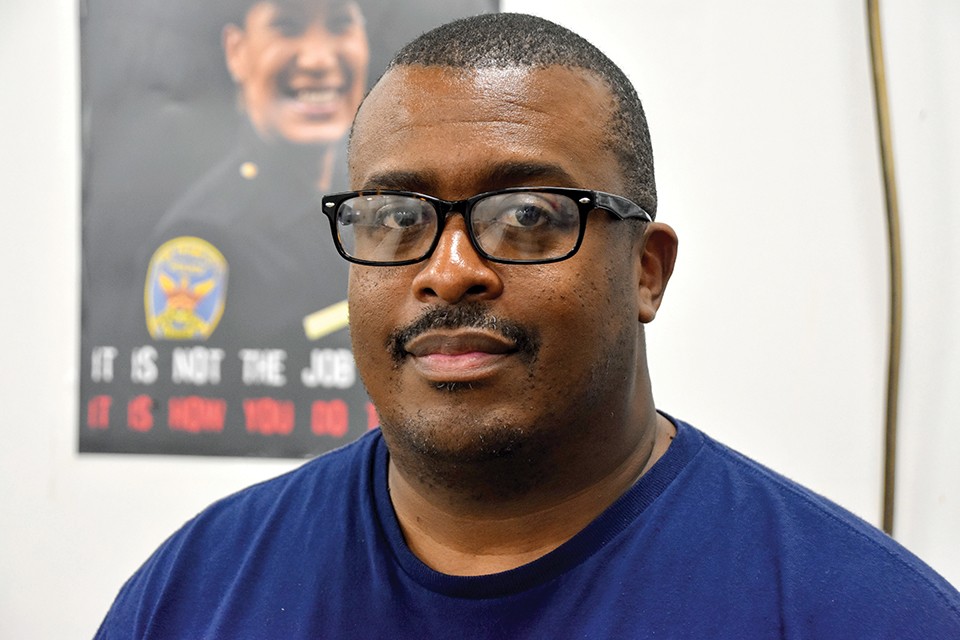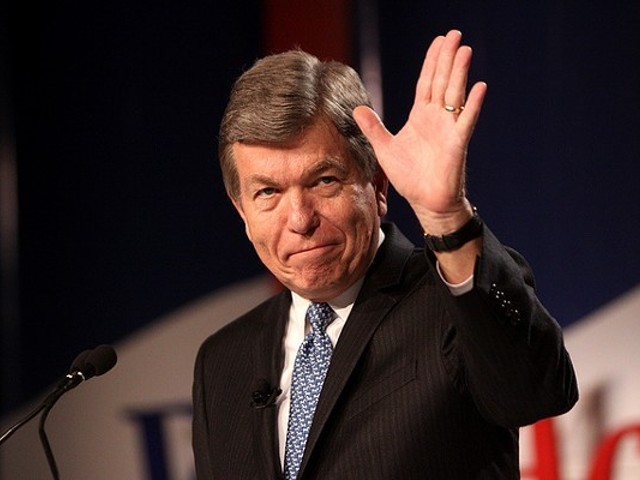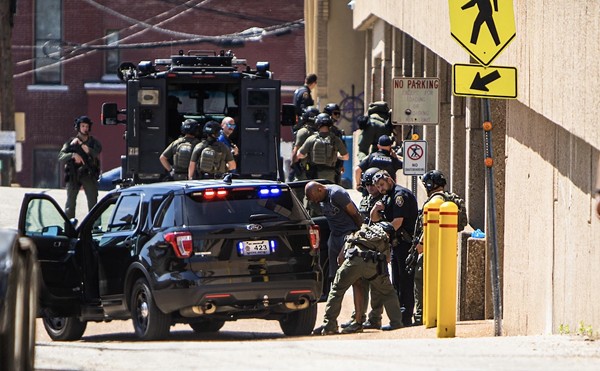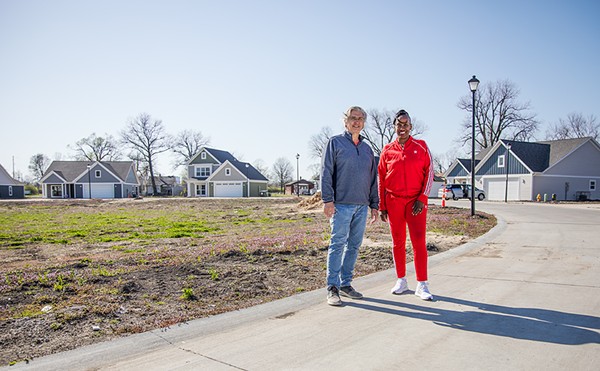It is often said that St. Louis has two police unions, one white, one Black. This is, confusingly, both accurate and inaccurate.
While the department officially recognizes two police associations, only one — the "white police union" known as the St. Louis Police Officers' Association — has a seat at the table when it comes to contracts and collective bargaining on behalf of the city's current force of some 1,200 uniformed cops.
Meanwhile, the Ethical Society of Police counts 372 dues-paying city officers, most of them Black. The scope of representation is limited to legal and internal disciplinary cases. However, both associations are roughly the same age, with the SLPOA arising in 1968 as part of a blue backlash to the suspension of a group of officers who had brutally beaten two members of the Black Liberators militant group that September.
The beatings led to an eruption of protest and drew crowds to the home of Mayor Alfonso Cervantes. Weeks later, the state's Board of Police Commissioners, which controlled the department, ruled that the officers had violated police policy by using "greater force than required under the circumstances." According to reports at the time, hundreds of "dissident" white officers reacted in protest, demanding the suspended officers be reinstated and that the board break its own rules by allowing officers to form their own police association. At one meeting, 600 officers reportedly supported a motion for "an epidemic of sickness" if the board did not comply.
In a matter of weeks, the police board relented. It reinstated two suspended detectives and lifted disciplinary action against four officers. The SLPOA was born soon after.
But Black St. Louis cops had been spurred into action as well. On January 7, 1969, the St. Louis Post-Dispatch first reported their efforts under the headline "Negro Policemen Plan to Form Own Group." The story quoted a Black patrolman who dubbed the nascent SLPOA a "white police officers' group" whose "racialist" members supported the pro-segregation presidential run of George Wallace, far-right conspiracists of the John Birch Society and the Ku Klux Klan.
Some 30 years later, when Heather Taylor entered the department's police academy, the divisions in the department were just as clear. The evidence distressed the idealistic former basketball player.
"I noticed that right away," she says. "Blacks sat with Blacks. Whites sat with whites. When you're an athlete you sit with everyone. Where I'm from, you pass the ball to whoever is closest to the basket, who's ever open, if you want to win."
It wasn't just the seating arrangements at lunch that concerned her. Over the weeks of training, she grew frustrated with the way her instructors and fellow recruits described the city and people she would soon be serving. She recoiled when she heard white classmates offhandedly describe the Black Panthers as a terrorist organization. ("I looked at them, like, 'You don't know anything,'" she says now.)
She found herself thinking: "These are the people I have to count on, and we can't even get ourselves together about simple stuff?"
It was in the academy that Taylor started earning the reputation that would follow her for the rest of her career. One day, she says, she "snapped."
"I complained in front of the whole class and instructors," she recalls. "I told them, 'We can't be divided. If we're going to go out, I'm supposed to rely on you to protect me and save my life. And we can't even get along?'"
Taylor considered dropping out of the academy, but the next day she was back at her seat, a familiar mantra in her head: "I'm going to push on, I'm going to change it, I'm going to do better."
A police department, of course, is not a basketball team. Unlike hoops, police work is governed by the chaotic referees of St. Louis' geography and population. The court is a nearly 50 percent Black city whose violence falls along the same footprint as its history of poverty, segregation and redlining. Taylor noticed that the department's command ranks and specialized units were overwhelmingly white. When she started talking to other Black officers, the advice they gave her was grimly straightforward: When, not if, she confronted racism at the department, don't expect the St. Louis Police Officers' Association to back her up.
That's where the Ethical Society of Police came in. It was a lesson she learned quickly.
She remembers, "You knew in police academy there was a Black police association and a white association, with different reasons why they existed."
It wasn't just racism that challenged her. On her very first day on duty as a sworn police officer, Taylor sat down at her computer — and was startled to feel the hands of a male sergeant rubbing her head and neck. She remembers jolting away and telling him, "Don't you touch me."
"He said, 'Oh I thought you were someone else,'" she recalls. "I knew he was full of shit all day. Who does that? I had to work with that sergeant. This is what they don't prepare you for."
Heather Taylor's first assignment landed her in the old District 3, a beat covering a chunk of the central corridor south of Highway 44. She started with small drug cases — "the most pettiest crimes," she calls them now — busting suspects with a few pieces of crack.
"I didn't make a lot of drug arrests in my career," she says. In her first years, "I made a lot of stolen car arrests. Violent crime was my push anyway."
She was learning other lessons, too. While in her first assignment, Taylor recalls a white sergeant attempting to compliment her after overhearing the rookie cop on the phone. The sergeant's choice of compliment, "You're so articulate," was one Taylor understood to include the unspoken coda "for a Black person."
Taylor says she tried to gloss over the incident. But later that same month, she says she was back on desk duty and talking with a white lieutenant. Their conversation turned to an open position in the South Patrol's detective bureau.
"I was like, 'Man, what do I need to get into the bureau?'" she recalls. "And he was like, 'Oh, we already have a Black female there.'"
"It was pretty awful," she says now. "Like, only one Black female can do the job?"
She tried to move on from that comment, too, but, like a lot of the seemingly minor workplace incidents she experienced as a cop, they loomed larger as she perceived the pattern in their practice. Hearing a high-ranking officer's dismissal of her aspirations was an "aha" moment, she says: "Like, oh, this is why you only have two Blacks in the division, one Black male, Black female, that's the quota. It didn't matter how well you write, how well you investigate."
Taylor's talent for policing soon pulled her to new assignments. Her first years were spent in the anti-crime unit, and then, in 2003, she made detective and was transferred to juvenile cases and sex crimes. There was nothing petty about these cases. The culprits were rapists and child abusers. While some of the crimes left her feeling sick, she was doing exactly what she'd always imagined cops should be doing: holding people accountable for their actions. Helping the victimized. Serving justice.
In November 2012, she joined the homicide division's night shift. She estimates she investigated 400 murder scenes over the next eight years, a timeframe that saw the city's annual homicide count climb to the 200s, the highest they've been in a generation. People killed each other out of passion, anger or for seemingly no reason at all.
Some cases went cold, others led to convictions. But on some level, she admits, she never understood them.
"I had a case where a sister murdered her brother over referencing Nicki Minaj as a whore. She stabbed him. Her brother died a year later," she says. "I can't fathom it, picking up a knife, let alone being my own brother. I can't fathom any of my homicide scenes. Someone taking a samurai sword and slicing someone up in a house in south St. Louis? I can't."
What she could understand, after years of lessons, was the police department. She'd learned that people do things they think they can get away with. She made sure the officers around her understood what she would not tolerate.

Clarence Hines spent 21 years as a city cop, including time in the anti-crime unit with Taylor in the early 2000s.
"When I first met Heather, I honestly feel like she was in the process of becoming the Heather that we know and see right now," he says. "I think she was really looking for her voice, maybe even with some trepidation, wrestling with this idea of what is true justice, what is truth."
He adds, "I think we've all been there. Some never get past that hurdle."
Hines retired in 2012 to open a ministry and volunteer his time at Ethical. By then, Taylor had joined the association's board for a few years. She even ran for president of the organization in 2013, but was defeated by an officer who would loom large in ESOP's future.
After losing the election, Taylor took a break from the Ethical board. In 2014, she was still working murders as the rest of the city slept.
That year, however, her integrity as an investigator, and her sense of true justice, would be tested in a very different way. Not by death or violence, but betrayal.







